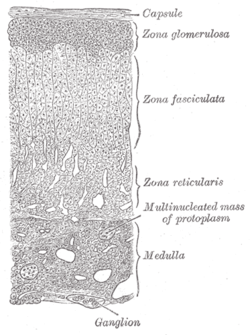Zona fasciculata
| Zona fasciculata | |
|---|---|
 Layers of adrenaline gland. | |
| Details | |
| Latin | Zona fasciculata |
The zona fasciculata constitutes the middle zone of the adrenal cortex, sitting directly beneath the zona glomerulosa. Constituent cells are organized into bundles or "fascicles".
The zona fasciculata chiefly produces glucocorticoids (mainly cortisol in the human), which regulates the metabolism of glucose, especially in times of stress (e.g., part of the fight-or-flight response), it is stimulated by the hormone Adrenocorticotropic Hormone (ACTH) which is released from the anterior portion of the pituitary and axised upon this adrenal gland. This tissue also generates a small amount of weak androgens (e.g., dehydroepiandrosterone). The main source of androgens will come from the zona reticularis region. In certain animals such as rodents, the lack of 17alpha-hydroxylase results in the synthesis of corticosterone instead of cortisol.
Steroid-producing adrenal tumours and hyperplasia of the zona fasciculata result in excess cortisol production and are the cause for adrenal Cushing's syndrome. The genetic disorder McCune-Albright syndrome can also present Cushing's syndrome in affected patients.
External links
- Histology image: 14502loa – Histology Learning System at Boston University
- Anatomy Atlases - Microscopic Anatomy, plate 15.292 - "Adrenal Gland"